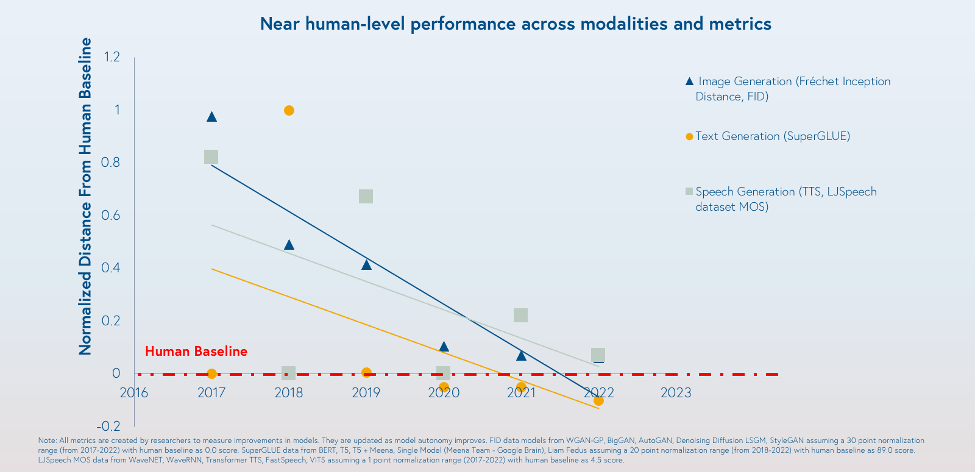Thinking Ahead: Decoding AI

|
Amid what’s felt like a futuristic fever sweeping the globe, I’ve been hesitant to weigh in on the topic of artificial intelligence (AI). As an investor, it often pays to be contrarian, and there is already an enormous amount of hype surrounding the potential for this technology that extends far beyond the world of investing.
With that being said, AI has been a key point of interest at Wavelength since we launched the firm over a decade ago to help investors pursue opportunities in fixed income markets that were changing with new technology and the increased availability of data. AI provides the rule-based foundation for the logic we’ve built into our investment process, and it is something we shared perspectives on years ahead of the current surge in interest (including in 2017 with Artificial Intelligence for Investing and in 2018 collaborating with PwC for Smart Money: AI Transitions from Fad to Future of Institutional Investing).
Accordingly, in this moment of near-deafening buzz, I’d like to help investors cut through the noise to focus on the real changes taking place – because outside of the hype, I see recent developments in AI as a substantive platform shift that will make new tools and analytical methods available while changing the set of potential risks and opportunities across markets.
Background
Before anything else, I think it’s important to point out that AI has been around for decades and is already being used as a part of many investment processes. Looking back historically, several milestones provide useful context when thinking about where we are today with this technology and how it can impact the future.
Figure 1: Key Developments in Artificial Intelligence

Source: Wavelength Capital Management
As noted in the figure above, AI’s core concepts were established in the 1950s, and since then it’s taken on various forms that have demonstrated value in different areas – in some instances showing a real advantage over humans. From Alan Turing’s namesake test to expert systems and neural networks, work bringing computers to exhibit intelligent behavior has followed a couple of key paths that are important to understanding the crossroads we’re at today.
One of these paths involves symbolic artificial intelligence which codifies logic through rules – this is the driving force behind expert systems that translate human intuition into if/then statements. Many systematic investment strategies are expert systems that use computers to be more disciplined, efficient, and accurate than the humans who design them. While these systems generally lack the ability to acquire new knowledge without human experts codifying it, this limiting factor is sometimes useful when investing where an intuitive basis for decisions can provide an important advantage over purely statistical approaches.
The other is based on neural networks which attempt to mimic how the human brain operates. Early work in this area was slow due to processes requiring significant computing power, but more recently researchers have returned to the idea of giving a computer information instead of rules. Neural networks are the concept behind the large language models driving ChatGPT, and this is where significant investments are being made to drive the next wave of innovation in AI.
Recent Developments Point to a Platform Shift
Like the internet in the 1990s, cloud computing in the 2000s, and smartphones in the 2010s, generative AI is bringing about another platform shift as it rapidly approaches human benchmarks in areas that were previously out of reach. Recent developments have been supported by increased computing power, bringing us to an inflection point where large language models are showing how computers can simulate human intuition – a breakthrough that paves the way for new applications of technology to transform the economy.
Figure 2: Generative AI Reaching the Human Baseline

Source: Bessemer Venture Partners
The widespread adoption of ChatGPT was an early step in this process that touched a single space. Large language models are now being used broadly across content creation, image generation, and coding with tools like Jasper, DALL-E 2, and AlphaCode – and a host of well-funded startups are moving quickly to build new products that leverage generative AI to increase productivity across industries.
At the same time, established companies are embedding copilots within existing products to offer users ways to work alongside AI. With the release of Microsoft 365 Copilot, Satya Nadella explained “this new generation of AI will remove the drudgery of work and unleash creativity.” And it’s through these types of complementary processes that I expect the largest gains to be made, as people use new tools in conjunction with established methods to unlock greater insights and productivity.
What does this mean for investors?
As with the platform shifts highlighted above, businesses will need to adapt, and this may be particularly true in knowledge-based, data-driven areas like investing. For generative AI, I find it useful to think through a lens of prediction where the technology is trained on datasets to infer relationships that lead to predicting what comes next – whether it’s the next word in a sentence or move in a market.
From this perspective, I see the greatest potential in generative AI offering tools that let investors perform faster, deeper, and more comprehensive analysis for what comes next, and in doing so exceeding what’s humanly possible. Large language models trained on financial data are already being made available by Bloomberg and other providers, and I see the technology being impactful for short-term signals with abundant price data for pattern recognition. And zooming out, I see large language models being used as an engine for research, where investment ideas can be extracted from data and then tested with human intuition. For whatever the analysis, however, a clear advantage will come from deploying it at a scale that’s not possible with human analysts, and I expect this to broaden the reach and capacity of the investment firms that incorporate generative AI in their processes moving forward.
The opportunities created by generative AI will also introduce risks, as many investment firms will misuse these tools or fail to adapt altogether. Purely statistical approaches to investing have always had issues – look no further than the graveyard of hedge fund blowups over the years – and lessons learned also apply to generative AI. Relying solely on the outputs of large language models to make investment decisions without reasoning risks serious pitfalls for investors, particularly where these models are trained on small or incomplete datasets that contain blind spots. In addition, there are bound to be unintended consequences if machines are given goals without sufficient constraints or intuitive checks – this was the case long before the rise of large language models and will be increasingly important as they gain the power to do more on their own.
In sum, the investment landscape is set to change substantially with the breakthroughs in generative AI as new and powerful tools become available. Investors will need to understand these tools through both their strengths and weaknesses in order to adapt and realize the advantages they can offer. In a fast-changing environment, I believe generative AI will provide investors with a new dimension of predictive power that can be combined with established methods and human intuition to conduct more efficient and effective types of analysis that ultimately lead to better investment decisions.***
DISCLAIMER:
Wavelength Capital Management, LLC (“Wavelength”) is an SEC-registered¹ investment adviser located in Connecticut. Wavelength may only transact business in those states in which it is notice filed or qualifies for a corresponding exemption from such requirements. Wavelength's website is limited to the dissemination of general information regarding its investment advisory services to United States residents residing in states where providing such information is not prohibited by applicable law.
Accordingly, the publication of Wavelength's website on the Internet should not be construed as Wavelength's solicitation to effect, or attempt to effect, transactions in securities or the rendering of personalized investment advice for compensation over the Internet.
Investing involves the risk of loss and investors should be prepared to bear potential losses. Past performance may not be indicative of future results and may have been impacted by events and economic conditions that will not prevail in the future. No portion of this commentary is to be construed as a solicitation to buy or sell a security or the provision of personalized investment, tax or legal advice. Certain information contained in this report is derived from sources that Wavelength believes to be reliable; however, the Firm does not guarantee the accuracy or timeliness of such information and assumes no liability for any resulting damages.
For information pertaining to the registration status of Wavelength, please view the United States Securities and Exchange Commission’s website at www.adviserinfo.sec.gov. A copy of Wavelength's current written disclosure statement discussing Wavelength's business operations, services and fees is available from Wavelength upon written request. Wavelength does not make any representations as to the accuracy, timeliness, suitability, completeness or relevance of any information prepared by any unaffiliated third party, whether linked to Wavelength's website or incorporated herein, and takes no responsibility therefore. All such information is provided solely for convenience purposes only and all users thereof should be guided accordingly.
¹ SEC registration does not indicate a certain level of skill or training.

